
Abul Muzaffar Muhy-ud-Din Muhammad Aurangzeb Alamgir
6th Mughal Emperor of India
| Born | 4 November 1618 Dahod, Mughal Empire |
|---|---|
| Died | 3 March 1707 (aged 88) Ahmednagar, Mughal Empire |
Abul Muzaffar Muhy-ud-Din Muhammad Aurangzeb Alamgir (4 November 1618 [O.S. 25 October] – 3 March 1707 [O.S. 20 February]), more commonly known as Aurangzeb or by his chosen imperial title Alamgir ("Conquerer of the World", Persian: عالمگیر), was the sixth Mughal Emperor of India, whose reign lasted from 1658 until his death in 1707.
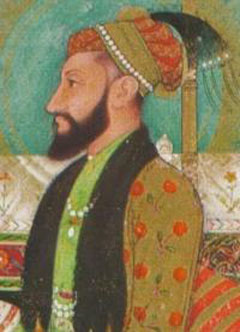
Badshah Aurangzeb Alamgir I, having ruled most of the Indian subcontinent for nearly half a century, was the second longest reigning Mughal emperor after the legendary Akbar. In this period he tried hard to get a larger area, notably in southern India, under Mughal rule than ever before. But after his death in 1707, the Mughal Empire gradually began to shrink. Major reasons include a weak chain of "Later Mughals", an inadequate focus on maintaining central administration leading to governors forming their own empires, a gradual depletion of the fortunes amassed by his predecessors and the growth of secessionist sentiments amongst the other communities of the empire like the Marathas.
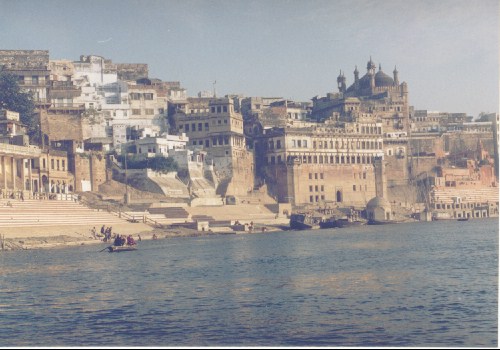
Aurangzeb Mosque
Rise to throne
Early life
Aurangzeb was the third son of the fifth Mughal emperor Shah Jahan and Mumtaz Mahal (Arjumand Bānū Begum). After a rebellion by his father, part of Aurangzeb's childhood was spent as a virtual hostage at his grandfather Jahangi's court. Muhammad Saleh Kamboh Salafi had been one of his childhood teachers.After Jahangir's death in 1627, Aurangzeb returned to live with his parents. Shah Jahan followed the Mughal practice of assigning authority to his sons, and in 1634 put Aurangzeb in charge of the Deccan campaign. Following his success in 1636, Aurangzeb became Subahdar (governor) of the Deccan. At this time, he began building a new city near the former capital of Khirki which he named Aurangabad after himself. In 1637, he married Rabia Durrani. During this period the Deccan was relatively peaceful. In the Mughal court, however, Shah Jahan began to show greater and greater favoritism to his eldest son Dara Shikoh.
In 1644, Aurangzeb's sister Jahanara Begum was accidentally burned in Agra. This event precipitated a family crisis which had political consequences. Aurangzeb suffered his father's displeasure when he returned to Agra three weeks after the event, instead of immediately. Shah Jahan dismissed him as the governor of the Deccan. Aurangzeb later claimed (1654) that he had resigned in protest of his father favoring Dara

In 1645, he was barred from the court for seven months. But later, Shah Jahan appointed him governor of Gujarat; he performed well and was rewarded. In 1647, Shah Jahan made him governor of Balkh and Badakhshan (in modern Afghanistan and Tajikistan), replacing Aurangzeb's ineffective brother Murad Baksh. These areas at the time were under attack from various forces and Aurangzeb's military skill proved successful.
He was appointed governor of Multan and Sindh, and began a protracted military struggle against the Safavid army in an effort to capture the city of Kandahar. He failed, and fell again into his father's disfavour.
In 1652, Aurangzeb was re-appointed governor of the Deccan. In an effort to extend the empire, Aurangzeb attacked the border kingdoms of Golconda (1657), and Bijapur (1658). Both times, Shah Jahan called off the attacks near the moment of Aurangzeb's triumph. In each case Dara Shikoh interceded and arranged a peaceful end to the attacks.
War of succession
Shah Jahan fell ill in 1657. With this news, the struggle for the succession began. Aurangzeb's eldest brother, Dara Shikoh, was regarded as heir apparent, but the succession proved far from certain when Shah Jahan's second son Shah Shuja declared himself emperor in Bengal. Imperial armies sent by Dara and Shah Jahan soon restrained this effort, and Shuja retreated.
Soon after, Shuja's youngest brother Murad Baksh, with secret promises of support from Aurangzeb, declared himself emperor in Gujarat. Aurangzeb, ostensibly in support of Murad, marched north from Aurangabad, gathering support from nobles and generals. Following a series of victories, Aurangzeb declared that Dara had illegally usurped the throne. Shah Jahan, determined that Dara would succeed him, handed over control of his empire to Dara. A Rajput lord opposed to Aurangzeb and Murad, Maharaja Jaswant Singh, battled them both at Dharmatpur near Ujjain. Aurangzeb eventually defeated Singh and concentrated his forces on Dara. A series of bloody battles followed, with troops loyal to Aurangzeb battering Dara's armies at Samugarh. In a few months, Aurangzeb's forces surrounded Agra. Fearing for his life, Dara departed for Delhi, leaving Shah Jahan behind. The old emperor surrendered the Agra Fort to Aurangzeb's nobles, but Aurangzeb refused any meeting with his father, and declared that Dara was no longer a Muslim.
In a sudden reversal, Aurangzeb arrested his brother Murad, whose former supporters defected to Aurangzeb in return for rich gift Meanwhile, Dara gathered his forces, and moved to the Punjab. The army sent against Shuja was trapped in the east, its generals Jai Singh and Diler Khan, submitted to Aurangzeb, but allowed Dara's son Suleman to escape. Aurangzeb offered Shuja the governorship of Bengal. This move had the effect of isolating Dara and causing more troops to defect to Aurangzeb. Shuja, however, uncertain of Aurangzeb's sincerity, continued to battle his brother, but his forces suffered a series of defeats at Aurangzeb's hands. Shuja fled to Arakan (in present-day Burma), where he was executed after leading a failed coup. Murad was finally executed, ostensibly for the murder of his former divan Ali Naqi, in 1661.
With Shuja and Murad disposed of, and with his father Shah Jahan confined in Agra, Aurangzeb pursued Dara, chasing him across the north-western bounds of the empire. After a series of battles, defeats and retreats, Dara was betrayed by one of his generals, who arrested and bound him. In 1659, Aurangzeb arranged his formal coronation in Delhi. He had Dara openly marched in chains back to Delhi; when Dara finally arrived, Aurangzeb had him executed on 30 August 1659. Having secured his position, Aurangzeb kept an already weakening Shah Jahan under house arrest at the Agra Fort. Shah Jahan died in 1666.
Aurangzeb's reign
Establishment of Islamic law
Soon after his ascension, Aurangzeb purportedly abandoned the liberal religious viewpoints of his predecessors. Though Akbar, Jahang and Shah Jah's approach to faith was more syncretic than the empire's founder, Aurangzeb's position is not so obvious. While his conservative interpretation of Islam and belief in the Sharia (Islamic law) is well documented, how this affected the empire remains unclear. Despite claims of sweeping edicts and policies, contradictory accounts exist. Specifically, his compilation of the Fatawa-e-Alamgiri, a digest of Muslim law, was either intended for personal use, never enforced, or only poorly done. While some assert the lack of broad adoption was due to an inherent flaw, others insist they were only intended for his observance. While it is possible the war of succession and a continued incursions combined with Shah Jahan's spending made cultural expenditures impossible, Aurangzeb's orthodoxy is also used to explain his infamous "burial" of music. The scene describing the "death of music"(and all other forms of performance) is paradoxically dramatic.
Niccolao Manucci's Storia do Mogor and Khafi Khan's Muntakhab al-Lubab are the only documents which describe the aforementioned event. In Storia do Mogor, Manucci describes the ramifications of Aurangzeb's 1668 decree. Here, Aurangzeb's instructions for the muhtasib seem particularly damning:
In Hindustan both Moguls and Hindus are very fond of listening to songs and instrumental music. He therefore ordered the same official to stop music. If in any house or elsewhere he heard the sound of singing and instruments, he should forthwith hasten there and arrest as many as he could, breaking the instruments. Thus was caused a great destruction of musical instruments. Finding themselves in this difficulty, their large earnings likely to cease, without there being any other mode of seeking a livelihood, the musicians took counsel together and tried to appease the king in the following way: About one thousand of them assembled on a Friday when Aurangzeb was going to the mosque. They came out with over twenty highly-ornamented biers, as is the custom of the country, crying aloud with great grief and many signs of feeling, as if they were escorting to the grave some distinguished defunct. From afar Aurangzeb saw this multitude and heard their great weeping and lamentation, and, wondering, sent to know the cause of so much sorrow. The musicians redoubled their outcry and their tears, fancying the king would take compassion upon them. Lamenting,they replied with sobs that the king's orders had killed Music, therefore they were bearing her to the grave. Report was made to the king, who quite calmly remarked that they should pray for the soul of Music, and see that she was thoroughly well buried. In spite of this, the nobles did not cease to listen to songs in secret. This strictness was enforced in the principal cities.This implies he not only placed a prohibition on music, but actively sought and crushed any resistance. Without music, and implicitly dance, many Hindu-inspired practices would have been impossible. Lavish celebrations of the Emperor's birthday, commonplace since the time of Akbar, would certainly be forbidden under such conditions. Oddly, artistic work not only steadied during Aurangzeb's reign, it increased. Amidst these and other contradictions, the validity and bias of Manucci and Khafi Khan's work is being questioned.
Another particularly heinous claim against Aurangzeb, was his policy of temple destruction. Though figures vary wildly from 80 to 60,000, it clearly took place to some extent. However, Aurangzeb's Firmans on behalf of the Balaji or Vishnu Temple, Varanasi insist these events weren't universal. Noted Historian Richard Eaton believes the overall understanding of temples to be flawed. As early as the sixth century, temples became vital political landmarks as well as religious ones. In fact, not only was temple desecration widely practiced and accepted, it was a necessary part of political struggle.
Francois Bernier, traveled and chronicled Mughal India during the war of succession, notes both Shah Jahan and Aurangzeb's distaste for Christians. This led to the demolition of Christian settlements near the British/European Factories and enslavement of Christian converts by Shah Jahan. Furthermore, Aurangzeb stopped all aid to Christian Missionaries (Frankish Padres) initiated by Akbar and Jahangir
Aurangzeb's views on the Jizya (poll tax)
From Aurangzeb's Fatwa:[Jizyah] refers to what is taken from the Dhimmis, according to [what is stated in] al-Nihayah. It is obligatory upon [1] the free, [2] adult members of [those] who are generally fought, [3] who are fully in possession of their mental faculties, and [4] gainfully employed, even if [their] profession is not noble, as is [stated in] al-Sarajiyyah. There are two types of (jizyah). [The first is] the jizyah that is imposed by treaty or consent, such that it is established in accordance with mutual agreement, according to (what is stated in) al-Kafi. (The amount) does not go above or below (the stipulated) amount, as is stated in al-Nahr al-Fa’iq. (The second type) is the jizyah that the leader imposes when he conquers the unbelievers (kuffar), and (whose amount) he imposes upon the populace in accordance with the amount of property [they own], as in al-Kafi. This is an amount that is pre-established, regardless of whether they agree or disagree, consent to it or not.
The wealthy (are obligated to pay) each year forty-eight dirhams (of a specified weight), payable per month at the rate of 4 dirhams. The next, middle group (wast al-hal) [must pay] twenty-four dirhams, payable per month at the rate of 2 dirhams. The employed poor are obligated to pay twelve dirhams, in each month paying only one dirham, as stipulated in Fath al-Qadir, al-Hidayah, and al-Kafi. (The scholars) address the meaning of "gainfully employed", and the correct meaning is that it refers to one who has the capacity to work, even if his profession is not noble. The scholars also address the meaning of wealthy, poor, and the middle group. Al-Shaykh al-Imam Abu Ja‘far, may Allah the most high have mercy on him, considered the custom of each region decisive as to whom the people considered in their land to be poor, of the middle group, or rich. This is as such, and it is the most correct view, as stated in al-Muhit. Al-Karakhi says that the poor person is one who owns two hundred dirhams or less, while the middle group owns more than two hundred and up to ten thousand dirhams, and the wealthy (are those) who own more than ten thousand dirhams...The support for this, according to al-Karakhi is provided by the fatawa of Qadi Khan (d. 592/1196). It is necessary that in the case of the employed person, he must have good health for most of the year, as is stated in al-Hidayah. It is mentioned in al-Idah that if a dhimmi is ill for the entire year such that he cannot work and he is well off, he is not obligated to pay the jizyah, and likewise if he is sick for half of the year or more. If he quits his work while having the capacity (to work) he (is still liable) as one gainfully employed, as is [stated in] al-Nihayah. No jizyah is imposed upon their women, children, ill persons or the blind, or likewise on the paraplegic, the very old, or on the unemployed poor, as is stated in al-Hidayah.
Expansion of the Mughal Empire
From the start of his reign up until his death, Aurangzeb engaged in almost constant warfare. He built up a massive army, and began a program of military expansion along all the boundaries of his empire. Aurangzeb pushed north-west into the Punjab and what is now Afghanistan; he also drove south, conquering three Muslim kingdoms: Nizams's of Ahmednagar, Adilshahi's of Bijapur and Qutbshahi's of Golconda.
Nizams's of Ahmednagar, Adilshahi's of Bijapur mostly surrendered and their territories were administered by Mughal Nawab. Qutbshahi's of Golconda however refused to surrender they fortified themselves at Golconda Fort, and fiercely protected Kollur Mine (the worlds only diamond mine). After a long siege Mughal forces managed to penetrate the walls by capturing a gate. Qutbshahi's of Golconda and Abul Hasan Qutb Shah surrendered and handed over the Nur-Ul-Ain Diamond, The Hope Diamond, Wittelsbach Diamond and the The Regent Diamond making the Mughal Emperor the richest monarch in the world.
This combination of military expansion and religious intolerance had deeper consequences. Though he succeeded in expanding Mughal control, it was at an enormous cost in lives and treasure. And, as the empire expanded in size, Aurangzeb's chain of command grew weaker. The Sikhs of the Punjab grew both in strength and numbers, and launched rebellions. The Marathas waged a war with Aurangzeb which lasted for 27 years. Even Aurangzeb's own armies grew restive — particularly the fierce Rajputs, who were his main source of strength. Aurangzeb gave a wide berth to the Rajputs, who were mostly Hindu. While they fought for Aurangzeb during his life, on his death they immediately revolted against his successors.
With much of his attention on military matters, Aurangzeb's political power waned, and his incompetent provincial Nawabs grew in authority.
Revenue administration
Emperor Aurangzeb's exchequer raised a record £100 million in annual revenue through various sources like taxes, customs and land revenue, et al. from 24 provinces. A pound sterling was exchanged at 10 rupees then.| No. | Province | Land Revenue (1697) | Notes |
|---|---|---|---|
| - | Total | £38,624,680 | |
| 1 | Bijapur | £5,000,000 | |
| 2 | Golconda | £5,000,000 | |
| 3 | Bengal | £4,000,000 | |
| 4 | Gujarat | £2,339,500 | |
| 5 | Lahore | £2,330,500 | |
| 6 | Agra | £2,220,355 | |
| 7 | Ajmere | £2,190,000 | |
| 8 | Ujjain | £2,000,000 | |
| 9 | Deccan | £1,620,475 | |
| 10 | Berar | £1,580,750 | |
| 11 | Delhi | £1,255,000 | |
| 12 | Behar | £1,215,000 | |
| 13 | Khandesh | £1,110,500 | |
| 14 | Rajmahal | £1,005,000 | |
| 15 | Malwa | £990,625 | |
| 16 | Allahabad | £773,800 | |
| 17 | Nande (Nandair) | £720,000 | |
| 18 | Baglana | £688,500 | |
| 19 | Tatta (Sind) | £600,200 | |
| 20 | Orissa | £570,750 | |
| 21 | Multan | £502,500 | |
| 22 | Kashmir | £350,500 | |
| 23 | Kabul | £320,725 | |
| 24 | Bakar | £240,000 |
Coins Gallery
Rebellions
Aurangzeb's reign is marked by numerous rebellions in the distant provinces of the Mughal Empir, many historians believe that Mughal Nawabs were incapable of bridging the gap between the rulers and the people; therefore many new identities emerged along with it armed rebellion.- In 1669, the Jat peasants of Bharatpur around Mathura revolted and led to the formation of Bharatpur state, they formulated a fierce rebellion around the Mughal capitol.
- In 1670, Shivaji, assissanited the Adil Shahi commander Afzal Khan and later his rebels almost killed the Mughal Viceroy Shaista Khan, and waged the war against the Mughal Emperor Aurangzeb. Shivaji and his forces ravaged the Deccan, Janjira and tried to gain control of vast territories. However by 1689 Auranzeb's armies had captured the successor of Shivaji, his son Sambhaji alive and executed. But even after Sambhaji's death, Aurangzeb could never completely eradicate the Maratha rebels ever in his 27 years of war against them.
- In 1672, the Satnami, a sect concentrated in an area near Delhi, under the leadership of Bhirbhan and some Satnami, took over the administration of Narnaul, but they were eventually crushed upon Aurangzeb's personal intervention with very few escaping alive.
- In 1699, on his orders the Mughal governor of Sarhind surrounded the fort of Anandpur in Punjab, which was occupied by Guru Gobind Singh and well armed Sikhs. After oaths of safety by the Mughal forces, Guru Gobind Singh decided to leave the fort. However the Mughal forces broke their promises and attacked the Guru and the Sikhs. The Mughals held his 2 young sons Sahibzada Zorawar Singh and Sahibzada Fateh Singh captive and executed through Immurement. Meanwhile his elder sons (15 and 17 years old) named Sahibzada Jujhar Singh and Sahibzada Ajit Singh fell fighting Mughal Musketeers at Chamkaur (close to Anandpur Fort). Gobind Singh wrote a letter named Zafarnamah to Aurungzeb. The letter is written in exquisite Persian verse. In this letter, Guru Gobind Singh Ji reminds Aurangzeb how he and his henchmen had broken their oaths taken by the holy Qu'ran and loyalty to the Mughal Empire.
- In 1671, The Battle of Saraighat between the Mughal Empire , and the Ahom Kingdom. During the battle the Mughal's were led by Mir Jumla II and Shaista Khan. During the course of the battle the Mughal Admiral, Munnawar Khan was killed.
The Deccan wars and the Rise of the Marathas
In the time of Shah Jahan, the Deccan had been controlled by three Muslim kingdoms: Ahmednagar (Nizams), Bijapur (Adilshahi) and Golconda (Qutbshahi). Following a series of battles, Ahmednagar was effectively divided, with large portions of the kingdom ceded to the Mghals and the balance to Bijapur. One of Ahmednagar's generls, a Hindu Maratha named Shahaji, joined the Bijapur court. Shahaji sent his wife Jijabai and young son Shivaji in Pune to look after his Jagir.
In 1657, while Aurangzeb attacked Golconda and Bijapur, Shivaji, using guerrilla tactics, took control of three Adilshahi forts formerly controlled by his father. With these victories, Shivaji assumed de facto leadership of many independent Maratha clans. The Marathas harried the flanks of the warring Adilshahi and Mughals, gaining weapons, forts, and territories.[29] Shivaji's small and ill-equipped army survived an all out Adilshahi attack, and Shivaji personally killed the Adilshahi general, Afzal Khan. With this event, the Marathas transformed into a powerful military force, capturing more and more Adilshahi and Mughal territories.
Just before Shivaji Raje's his coronation in 1659, Aurangzeb sent his trusted general and maternal uncle Shaista Khan the Mughal Viceroy to the Deccan to recover lost forts occupied by the Maratha rebels. Shaista Khan drove into Maratha territory and took up residence in Pune. In a daring raid, Shivaji attacked the governor's residence in Pune during a midnight wedding celebration. The Marathas killed Shaista Khan's son, even hacking off most of Shaista Khan's hand. Shaista Khan however barely survived and was re-appointed as the administrator of Bengal and was a key commander in the war against the Ahoms.
Aurangzeb ignored the rise of the Marathas for the next few years as he was occupied with other religious and political matters including the rise of Sikhism. Shivaji captured forts belonging to both Mughals and Bijapur. At last Aurangzeb sent his powerful general Raja Jai Singh of Amber, a Hindu Rajput, to attack the Marathas. Jai Singh won fort of Purandar after fierce battle in which the maratha commander Murarbaji fell. Foreseeing defeat, Shivaji agreed for a truce and meeting Aurangjeb at Delhi. Jai Singh also promised the Maratha hero his safety, placing him under the care of his own son, the future Raja Ram Singh I. However, circumstances at the Mughal court were beyond the control of the Raja, and when Shivaji and his son Sambhaji went to Agra to meet Aurangzeb, they were placed under house arrest, from which they managed to effect a daring escape.
Shivaji returned to the Deccan, and was crowned Chhatrapati or Emperor of the Maratha Empire in 1674. While Aurangzeb continued to send troops against him, Shivaji expanded Maratha control throughout the Deccan until his death in 1680. Shivaji was succeeded by his son Sambhaji. Militarily and politically, Mughal efforts to control the Deccan continued to fail. Aurangzeb's son Akbar left the Mughal court and joined Muslim rebels in Deccan. Aurangzeb in response moved his court to Aurangabad and took over command of the Deccan campaign. More battles ensued, and Akbar fled to Persia and never returned.
In 1689 Aurangzeb's forces captured Sambhaji, his successor chhatrapati Rajaram and his, Maratha forces fought individual battles against the forces of the Mughal Empire, and territory changed hands again and again during years of endless warfare. As there was no central authority among the Marathas, Aurangzeb was forced to contest every inch of territory, at great cost in lives and treasure against an organized force. Even as Aurangzeb drove west, deep into Maratha territory — notably conquering Satara — the Marathas expanded their attacks further into Mughal lands, including Mughal provinces of Malwa, Hyderabad, Jinji in TamilNadu. Aurangzeb waged continuous war in the Deccan for more than two decades with no resolution. Aurangzeb lost about a fifth of his army fighting rebellions led by the Marathas in Deccan India. He came down thousands of miles to the Deccan to conquer the Maratha confederacy and eventually died at the age of 90, during his final campaign against the Maratha confederacy.
Chatrapati
When Maharaja Jaswant Singh of Jodhpur died in 1679, a conflict ensued over who would be the next Raja. Aurangzeb's choice of a nephew of the former Maharaja was not accepted by other members of Jaswant Singh's family and they rebelled, but in vain. Aurangzeb seized control of Jodhpur. He also moved on Udaipur, which was the only other state of Rajputana to support the rebellion. There was never a clear resolution to this conflict, although it is noted that the other Rajputs, including the celebrated Kachhwaha Rajput clan of Raja Jai Singh, the Bhattis, and the Rathores, remained loyal. On the other hand, Aurangzeb's own third son, Prince Akbar, along with a few Muslim Mansabdar supporters, joined the rebels in the hope of dethroning his father and becoming emperor. The rebels were defeated and Akbar fled south to the shelter of the Maratha Chhatrapati Sambhaji, Chhatrapati Shivaji's successor.The Ahoms (the people of Shan community of Thailand) were the kings who had established their kingdom in the basin of river Bramhaputra and made it impossible for the Mughals to conquer that area.
The Pashtun rebellion
The Pashtun tribesmen of the Empire were considered the bedrock of the Mughal Army. They were crucial defenders of the Empire from the threat of invasion from the North-West as well as the main fighting force against the Sikh and Maratha forces. The Pashtun revolt in 1672 under the leadership of the warrior poet Khushal Khan Khattak was triggered when soldiers under the orders of the Mughal Governor Amir Khan allegedly attempted to molest women of the Safi tribe in modern day Kunar. The Safi tribes attacked the soldiers. This attack provoked a reprisal, which triggered a general revolt of most of tribes. Attempting to reassert his authority, Amir Khan led a large Mughal Army to the Khyber Pass. There the army was surrounded by tribesmen and routed, with only four men, including the Governor, managing to escape.After that the revolt spread, with the Mughals suffering a near total collapse of their authority along the Pashtun belt. The closure of the important Attock-Kabul trade route along the Grand Trunk road was particularly critical. By 1674, the situation had deteriorated to a point where Aurangzeb himself camped at Attock to personally take charge. Switching to diplomacy and bribery along with force of arms, the Mughals eventually split the rebellion and while they never managed to wield effective authority outside the main trade route, the revolt was partially suppressed. However the long term anarchy on the Empire's North-Western frontier that prevailed as a consequence ensured that the Persian Nadir Shah's forces half a century later faced little resistance on the road to Delhi, being one of the causes for Mughal decline and eventual European dominance.
Legacy
Aurangzeb's vast imperial campaigns against rebellion-affected areas of the Mughal Empire, caused his opponents to exaggerate the "importance" of their rebellions. The results of his vast campaigns were made worse by the incompetence of his regional Nawabs. His critics decry this as intolerance,.
Muslim views regarding Aurangzeb vary, most Muslim historians believe that the Mughal Emperor Aurangzeb was the last powerful ruler of an empire inevitably on the verge of decline. The major rebellions organized by the Sikhs and the Marathas were long embedded and had deep roots in the remote regions of the Mughal Empire.
Unlike his predecessors, Aurangzeb considered the royal treasury as a trust of the citizens of his empire. He made caps and copied Quran to earn money for his use. He did not use royal treasury for personal expenses or extravagant building projects except, perhaps, for one project: he built the famous Badshahi Mosque in Lahore, which, for 313 years remained the world's largest mosque and still remains to this day the 5th largest mosque in the world. He also added a small marble mosque known as the Moti Masjid (Pearl Mosque) to the Red Fort complex in Delhi. His constant warfare especially with Marathas, however, drove his empire to the brink of bankruptcy just as much as the wasteful personal spending and opulence of his predecessors.
Stanley Wolpert writes in his New History of India that:
He died in Ahmednagar on Friday, 20 February 1707 at the age of 88, having outlived many of his children. His modest open-air grave in Khuldabad expresses his deep devotion to his Islamic beliefs. The tomb lies within the courtyard of the shrine of the Sufi saint Shaikh Burham-u'd-din Gharib (died 1331), who was a disciple of Nizamuddin Auliya of Delhi.the conquest of the Deccan, to which, Aurangzeb devoted the last 26 years of his life, was in many ways a Pyrrhic victory, costing an estimated hundred thousand lives a year during its last decade of futile chess game warfare...The expense in gold and rupees can hardly be accurately estimated. [Aurangzeb]'s moving capital alone- a city of tents 30 miles in circumference, some 250 bazaars, with a 1⁄2 million camp followers, 50,000 camels and 30,000 elephants, all of whom had to be fed, stripped peninsular India of any and all of its surplus grain and wealth... Not only famine but bubonic plague arose...Even Aurangzeb, had ceased to understand the purpose of it all by the time he..was nearing 90... "I came alone and I go as a stranger. I do not know who I am, nor what I have been doing," the dying old man confessed to his son in February 1707. "I have sinned terribly, and I do not know what punishment awaits me.
After Aurangzeb's death, his son Bahadur Shah Itook the throne. The Mughal Empire, due both to Aurangzeb's over-extension and to Bahadur Shah's weak military and leadership qualities, entered a period of long decline. Immediately after Bahadur Shah occupied the throne, the Maratha Empire — which Aurangzeb had held at bay, inflicting high human and monetary costs — consolidated and launched effective invasions of Mughal territory, seizing power from the weak emperor. Within 100 years of Aurangzeb's death, the Mughal Emperor had little power beyond Delhi.
Source : Wikipedia
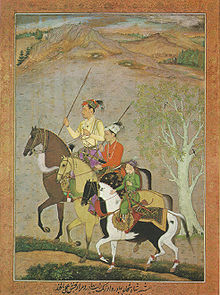


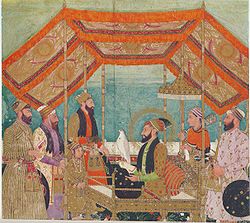




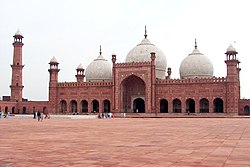

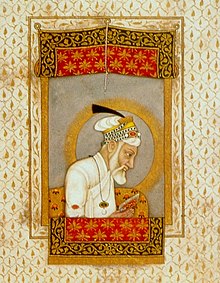

urdu histry Aurangzeb basha
ReplyDelete